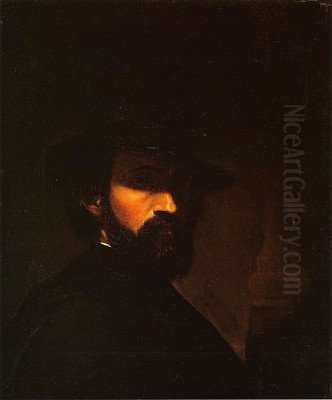
George Hetzel stands as a significant, if sometimes underappreciated, figure in the annals of American art, particularly renowned for his evocative landscapes of Western Pennsylvania and his pivotal role as an educator. Born in the Alsace region of France and maturing as an artist in the burgeoning industrial heartland of Pittsburgh, Hetzel's career bridged European academic traditions with a distinctly American sensibility for the natural world. His legacy is woven into the fabric of the Scalp Level School, an artistic movement he helped found, and his influence extended through his dedicated teaching and the enduring appeal of his finely wrought canvases.
From Alsatian Roots to American Soil
George Hetzel's journey began on July 17, 1826, in Hangwiller, a village nestled in the Alsace region of France, an area with a rich cultural tapestry influenced by both French and Germanic traditions. This bicultural heritage would subtly inform his life. His parents, Esther Beipst and George Hetzel Sr., made the momentous decision to emigrate to the United States when young George was merely two years old, in 1828. The Hetzel family settled in Allegheny City, a town across the Allegheny River from Pittsburgh, Pennsylvania, which was rapidly transforming into an industrial powerhouse.
Hetzel's father was a skilled craftsman, a carpenter and bridge builder, instilling in his son an appreciation for meticulous work. His mother, fluent in both German and French, likely contributed to George's linguistic abilities and perhaps his early exposure to European cultural nuances. He received his initial education in the public schools of Allegheny City. However, his artistic inclinations soon led him down a different path.
Early Artistic Stirrings and Apprenticeship
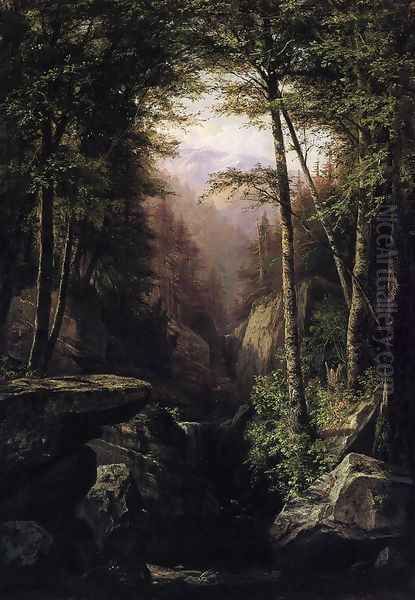
Following his formal schooling, Hetzel embarked on an apprenticeship that would provide the foundational skills for his future artistic endeavors. He trained in the practical arts of house and sign painting, and even decorated riverboats, a common trade for aspiring artists of the era. This hands-on experience was invaluable, teaching him the properties of pigments and the techniques of applying paint to various surfaces. It's documented that he also painted murals for some of Pittsburgh's churches, further honing his skills in composition and large-scale work. This period of practical application, though not fine art in the academic sense, was crucial in developing his technical proficiency and work ethic. It was a common route for many 19th-century American artists, including figures like Thomas Cole, who also had early experiences with decorative painting.
The Düsseldorf Sojourn: Academic Rigor and Chiaroscuro
Recognizing the need for formal training to elevate his craft, Hetzel, like many ambitious American artists of his generation, looked to Europe. In 1847, at the age of 21, he traveled to Germany to enroll in the prestigious Düsseldorf Art Academy. The Academy was a leading center for art education in Europe, attracting students from across the continent and North America. Artists like Emanuel Leutze, famous for his "Washington Crossing the Delaware," and Albert Bierstadt, later renowned for his grand depictions of the American West, also studied at Düsseldorf, though Bierstadt's time there was slightly later than Hetzel's.
At Düsseldorf, Hetzel studied from 1847 to 1849. He was fortunate to be under the tutelage of Professor Karl Ferdinand Sohn, a respected painter known for his historical subjects, portraits, and meticulous technique. Under Sohn, Hetzel immersed himself in the disciplines of still life and portraiture. Crucially, it was during this period that he delved deeply into the study of chiaroscuro – the dramatic use of light and shadow to create volume and mood. He particularly admired and studied the application of this technique by Renaissance masters like Leonardo da Vinci. This mastery of light and dark would become a hallmark of Hetzel's mature style, lending depth and atmosphere to his landscapes and still lifes. Other notable figures associated with the Düsseldorf School, known for its detailed realism and often narrative or sentimental content, included Andreas Achenbach and his brother Oswald Achenbach, both celebrated for their landscape and seascape paintings, and Johann Wilhelm Schirmer, a key figure in Düsseldorf landscape painting.
Return to Pittsburgh: Forging an American Vision
Upon his return to Pittsburgh in 1849, Hetzel was equipped with a sophisticated European academic training, yet his artistic vision would become increasingly rooted in the American landscape. He established a studio and began to build his reputation. While he initially undertook portrait commissions to support himself, his true passion lay in landscape painting. The rolling hills, dense forests, and winding rivers of Western Pennsylvania provided him with an abundance of subject matter.
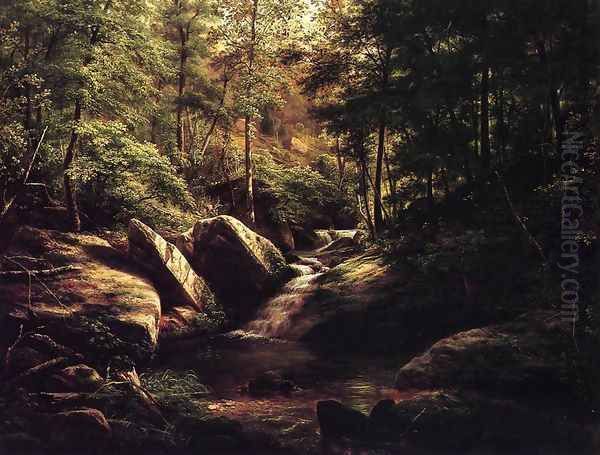
His European training, particularly the emphasis on careful observation and detailed rendering learned at Düsseldorf, served him well. However, he adapted these techniques to capture the unique character of the American wilderness. His landscapes from this period often exhibit a quiet, contemplative mood, rendered with a subtle palette and a keen sensitivity to atmospheric effects. He was not alone in this pursuit; the mid-19th century saw a flourishing of landscape painting in America, most famously with the Hudson River School, whose artists like Asher B. Durand and Jasper Cropsey (both of whom Hetzel knew) sought to celebrate the sublime beauty of the American continent.
The Scalp Level School: A Pennsylvanian Barbizon
One of Hetzel's most enduring contributions to American art history was his role in the formation of the Scalp Level School. Around 1866, Hetzel, along with a group of fellow Pittsburgh artists, began making regular sketching trips to a picturesque area along Paint Creek near the town of Scalp Level in Cambria County, Pennsylvania. This rural locale, with its old-growth forests, rocky streams, and rustic charm, became their outdoor studio.
The Scalp Level artists, much like the French Barbizon School painters such as Jean-Baptiste-Camille Corot, Jean-François Millet, and Théodore Rousseau, were drawn to direct observation of nature. They sought to capture the intimate, unadulterated beauty of the landscape, often working en plein air to record the fleeting effects of light and atmosphere. Hetzel was a leading figure in this group, and his farm near Scalp Level often served as a base for these artistic excursions.
Other artists associated with the Scalp Level School included John Wesley Beatty (who would later become the first director of fine arts at the Carnegie Institute), Alfred S. Wall, Joseph R. Woodwell, A.F. King, Clarence Johns, and Eugene Alonzo Poole. These artists, inspired by Hetzel's example and the camaraderie of the group, produced a significant body of work that documented the sylvan beauty of Western Pennsylvania. The Scalp Level School can be seen as a regional manifestation of the broader American landscape movement, sharing affinities with the Hudson River School's reverence for nature but often focusing on more intimate, less grandiose scenes.
Artistic Style: Realism, Light, and Intimacy
George Hetzel's artistic style is characterized by a blend of meticulous realism, learned in Düsseldorf, and a romantic sensibility towards nature. His landscapes are rarely grand or overtly dramatic in the manner of some Hudson River School painters like Frederic Edwin Church or Bierstadt. Instead, Hetzel favored more intimate woodland interiors, tranquil river scenes, and pastoral views.
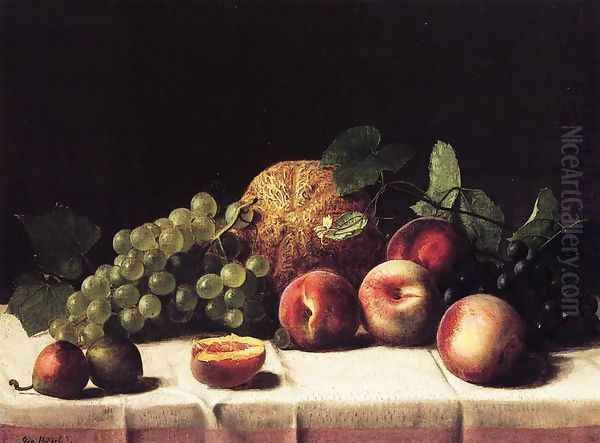
His mastery of chiaroscuro is evident in the way he rendered sunlight filtering through leaves, the deep shadows of a forest glen, or the play of light on water. This skillful manipulation of light and shadow imbued his paintings with a sense of depth, volume, and atmosphere. His palette was often subdued, favoring earthy tones and subtle gradations of color, which contributed to the quiet, contemplative mood of his work.
While primarily a landscape painter, Hetzel also excelled at still life. His still life compositions, often featuring fruits, flowers, or game, demonstrate the same careful attention to detail, rich textures, and sophisticated use of light found in his landscapes. These works reveal his strong academic grounding and his ability to find beauty in everyday objects.
Representative Works: Capturing the Pennsylvanian Essence
Several paintings stand out as representative of George Hetzel's oeuvre. "Rocky Gorge" (circa 1869) is a quintessential Scalp Level painting, depicting a sun-dappled stream cascading through a rocky, wooded ravine. The interplay of light and shadow, the detailed rendering of foliage and rock formations, and the overall sense of tranquil wilderness are characteristic of his best work from this period.
"Fisherman on the Conemaugh" is another notable landscape, showcasing his ability to integrate human figures harmoniously within a natural setting. The painting captures a serene moment, with the lone fisherman almost absorbed into the lush riverside environment. Similarly, "Trout Stream in the Alleghenies" exemplifies his skill in depicting the specific character of the Pennsylvanian wilderness, with its clear, rushing streams and dense forests.
In the realm of still life, "Still Life with Cantaloupe, Peaches and Grapes" demonstrates his technical virtuosity. The textures of the fruits, the sheen on the grapes, and the subtle reflections are rendered with remarkable fidelity, all brought to life by his characteristic use of chiaroscuro. Later in his career, he became particularly known for his still lifes featuring watermelons, which were widely admired and reproduced.
Hetzel the Educator: Nurturing Future Talents
Beyond his own artistic production, George Hetzel made a significant impact as an educator. For many years, he taught at the Pittsburgh School of Design for Women (later the Pittsburgh Female College). He was a dedicated and influential instructor, encouraging his students to develop their observational skills and to work directly from nature. Many of his students accompanied him on sketching trips to Scalp Level, absorbing his techniques and his passion for landscape painting.
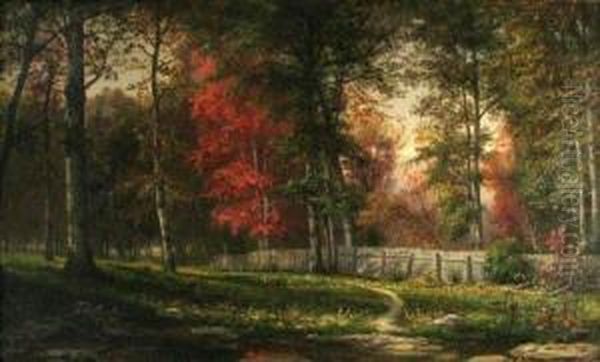
One of his most notable students was Olive Turney, who became an accomplished artist in her own right. Hetzel's daughter, Lila Hetzel, also became an artist and taught painting, continuing the family's artistic tradition. With John Wesley Beatty, Hetzel co-founded the Pittsburgh Art School, further cementing his role in the development of the city's artistic infrastructure. His commitment to teaching helped to cultivate a vibrant art scene in Pittsburgh and ensured that his artistic principles were passed on to a new generation.
Exhibitions, Recognition, and Later Years
George Hetzel's work gained recognition both regionally and nationally. He exhibited regularly in Pittsburgh and Philadelphia. His paintings were included in major national and international exhibitions, such as the Philadelphia Centennial Exposition of 1876, a landmark event that showcased American artistic and industrial achievements. He also exhibited at the Paris Exposition Universelle in 1867 and the World's Columbian Exposition in Chicago in 1893, bringing his depictions of the Pennsylvanian landscape to a wider audience.
In his later years, Hetzel continued to paint, dividing his time between his Pittsburgh studio and his country home near Scalp Level. He remained active in the Pittsburgh art community and continued to inspire fellow artists. His dedication to his craft never waned, and he produced a consistent body of work until his death.
George Hetzel passed away on July 4, 1899, in Edgewood, Pennsylvania, near Pittsburgh. He left behind a rich legacy as a painter, a teacher, and a central figure in the artistic life of Western Pennsylvania.
Enduring Legacy and Influence
The art of George Hetzel continues to be appreciated for its technical skill, its sensitive portrayal of nature, and its historical significance. His paintings are held in the collections of numerous museums, including the Westmoreland Museum of American Art in Greensburg, Pennsylvania, which has a substantial collection of his work and has organized retrospective exhibitions. The Carnegie Museum of Art in Pittsburgh also holds important examples of his paintings.
Hetzel's influence extends beyond his individual canvases. The Scalp Level School, which he was instrumental in founding, represents an important regional development in American landscape painting, demonstrating how national artistic trends were adapted and reinterpreted in different parts of the country. His role as an educator helped to foster a generation of artists in Western Pennsylvania, contributing to the growth of Pittsburgh as a cultural center.
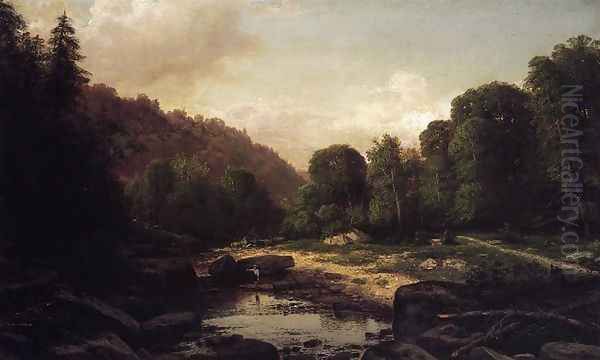
While perhaps not as widely known today as some of his Hudson River School contemporaries like Sanford Robinson Gifford or Martin Johnson Heade, George Hetzel's contribution to American art is undeniable. He was a master of his craft, a dedicated teacher, and a passionate chronicler of the natural beauty of his adopted home. His work provides a valuable window into the 19th-century American landscape and the artistic currents that shaped it, securing his place as a pivotal figure in the story of American painting. His dedication to capturing the essence of the Pennsylvanian wilderness, filtered through a European academic lens yet imbued with a distinctly American spirit, ensures his enduring relevance.